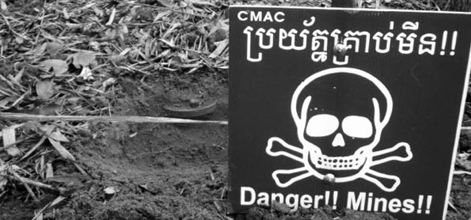Landmine Monitor 2011
Major Findings

© Andrian Gregorich, 5 April 2011Mine-contaminated area in Cambodia.
Global Landmine Overview 2010-2011
The Monitor identified three governments laying antipersonnel mines: Israel, Libya, and Myanmar.
- This is an increase since the previous report, with confirmed new use in Israel and Libya.
- Use by non-state armed groups was confirmed in four countries—Afghanistan, Colombia, Myanmar, and Pakistan—down from six countries in the last report.
The Monitor identified 12 producers of antipersonnel mines (the same number as reported in 2010 and the lowest total ever): China, Cuba, India, Iran, Myanmar, North Korea, Pakistan, Russia, Singapore, South Korea, the United States (US), and Vietnam.
A total of 4,191 new casualties were recorded in 2010, 5% more than in 2009 when 4,010 casualties were identified.
- The slight increase in recorded casualties is not yet indicative of a trend, due to poor quality of casualty data in some countries. The 2010 total is, however, lower than the 5,502 casualties recorded for 2008.
- Due to incomplete data collection, the actual number of casualties was certainly higher than what was recorded.
A total of 72 states, as well as seven disputed areas, were confirmed or suspected to be mine-affected.
- Emergency risk education is needed in Colombia, Myanmar, Pakistan, and Somalia; Libya, too, became a risk education priority following the outbreak of armed conflict in February 2011.
At least 200km2 of mined areas were cleared by 45 mine action programs in 2010, the highest annual total ever recorded by the Monitor (compared with 198km2 in 2009, the previous record, and 160 km2 in 2008).
- More than 388,000 antipersonnel mines and over 27,000 antivehicle mines were destroyed during this clearance.
- The largest total clearance of mined areas was achieved by programs in Afghanistan, Cambodia, Croatia, Iraq, and Sri Lanka, which together accounted for more than 80% of recorded clearance.
- An additional 460km2 of former battle area was reportedly cleared, destroying in the process more than 1.2 million items of unexploded ordnance. The largest totals were reported in Sri Lanka, Afghanistan, and Lao PDR.
Victim assistance in 2010 benefitted from a reoriented focus on service accessibility and availability, as well as some early efforts in a few states to combine the implementation of various complementary legal instruments.
- However, these improvements were at least in part offset by increases in armed violence that eroded accessibility and availability of services in several states with significant numbers of survivors.
- Donors reported providing US$43.6 million to support victim assistance activities, an increase of over $5 million from the previous year. However, this is only 9% of the global total of international assistance for mine action, the same percentage of total funding as in 2009.
Donors and affected states contributed approximately $637 million in international and national support for mine action in 2010.
- 31 donors contributed $480 million in international support for mine action in 57 affected states and areas, an increase of $34 million from 2009.
- This is the largest amount of donor contributions recorded by the Monitor and the fifth consecutive year that international contributions totaled over $400 million per year.
- Contributions from the top five mine action donors—the US, European Commission, Japan, Norway, and Canada—accounted for 64% of all donor funding.
- The top six recipient states—Afghanistan, Angola, Iraq, Sudan, Sri Lanka, and Cambodia —received 55% of all international mine action contributions in 2010.
- Twenty-four affected states provided $157 million in national support for mine action towards their own mine action programs, a decrease of $7 million from 2009, with lower contributions from Croatia and Angola accounting for most of the decrease.
|
The Good |
The Bad |
|
157 countries have joined the 1997 Mine Ban Treaty—80% of the world’s nations. |
|
|
Tuvalu acceded on 13 September 2011—the first state to join since Palau in November 2007. |
|
|
Two longstanding treaty holdouts—Finland and Poland—confirmed that measures are underway to join the treaty in 2012. |
A US policy review of the Mine Ban Treaty appeared to slow down in 2011. |
|
Highly disturbing allegations that security forces in Turkey used antipersonnel mines in 2009 remain unresolved. |
|
|
87 states have completed the destruction of their stockpiles: Iraq was added to this list in June 2011. |
While taking positive steps toward rectifying their non-compliance, Belarus, Greece, Turkey, and Ukraine remain in violation of the treaty’s obligation to destroy their stockpiles of antipersonnel mines within a four-year period. |
|
The rate of compliance with submitting annual transparency reports is at an all-time low (52%). |
|
|
A total of 18 States Parties have reported completion of their obligation to clear antipersonnel mines in known mined areas: Nigeria joined this group in June 2011. |
Requests for extending the deadline for clearance are becoming the norm rather than the exception; only Nicaragua has so far declared that it has completed its obligation after receiving an extension. |
|
Victim assistance in 2010 benefitted from a reoriented focus on service accessibility, availability, and some early efforts in a few states to combine the implementation of the Mine Ban Treaty, the Convention on the Rights of Persons with Disabilities, and the Convention on Cluster Munitions. |
|
|
In the first year implementing the Cartagena Action Plan’s provisions on victim assistance, States Parties mostly maintained existing coordination mechanisms and national victim assistance plans and, in a limited number of countries, began to address gaps in services in remote and rural areas. |

